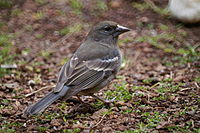Tenerife blue chaffinch
| Tenerife blue chaffinch | |
|---|---|

| |
| Male | |
| Scientific classification | |
| Domain: | Eukaryota |
| Kingdom: | Animalia |
| Phylum: | Chordata |
| Class: | Aves |
| Order: | Passeriformes |
| Family: | Fringillidae |
| Subfamily: | Fringillinae |
| Genus: | Fringilla |
| Species: | F. teydea
|
| Binomial name | |
| Fringilla teydea Webb, Berthelot & Moquin-Tandon , 1836 | |
The Tenerife blue chaffinch (Fringilla teydea) is a species of passerine bird in the finch family Fringillidae. It is endemic to Tenerife in Spain's Canary Islands. This bird is the natural symbol of this island, together with the Canary Islands dragon tree.[2]
Taxonomy
Until 2015, the species Fringilla teydea was classified into two subspecies: Fringilla teydea polatzeki from Gran Canaria and Fringilla teydea teydea from Tenerife.[3] However, a study published in March 2016 showed that a classification as different species, Fringilla polatzeki and Fringilla teydea, is justified.[4]
Description
Tenerife blue chaffinches resemble
Distribution
This bird is found only in the highlands of Tenerife.
The species' primary habitat is mountain
Behaviour
The Tenerife blue chaffinch's song is shorter and weaker than that of the common chaffinch, and the flight call is croakier. It primarily eats Canary Island pine seeds. Like the common chaffinch, but unlike most other finches, its young are fed extensively on insects.
Gallery
-
Female
-
Egg of Fringilla teydea teydeaMHNT
See also
References
- ^ . Retrieved 12 November 2021.
- ^ Símbolos de la naturaleza para las Islas Canarias [Natural Symbols for the Canary Islands] (Ley 7/1991) (in Spanish). Vol. 151. 30 April 1991. pp. 20946–20497 – via BOE.
- ^ ISBN 0-691-03424-9.
- .
- ISBN 92-871-3066-3.
External links
 Media related to Fringilla teydea at Wikimedia Commons
Media related to Fringilla teydea at Wikimedia Commons Data related to Tenerife blue chaffinch at Wikispecies
Data related to Tenerife blue chaffinch at Wikispecies



